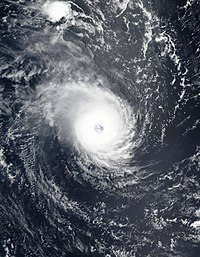
Photo from wikipedia
Abstract Disasters, such as cyclones, create conditions that increase the risk of infectious disease outbreaks. Epidemic forecasts can be valuable for targeting highest risk populations before an outbreak. The two… Click to show full abstract
Abstract Disasters, such as cyclones, create conditions that increase the risk of infectious disease outbreaks. Epidemic forecasts can be valuable for targeting highest risk populations before an outbreak. The two main barriers to routine use of real-time forecasts include scientific and operational challenges. First, accuracy may be limited by availability of data and the uncertainty associated with the inherently stochastic processes that determine when and where outbreaks happen and spread. Second, even if data are available, the appropriate channels of communication may prevent their use for decision making. In April 2019, only six weeks after Cyclone Idai devastated Mozambique’s central region and sparked a cholera outbreak, Cyclone Kenneth severely damaged northern areas of the country. By June 10, a total of 267 cases of cholera were confirmed, sparking a vaccination campaign. Prior to Kenneth’s landfall, a team of academic researchers, humanitarian responders, and health agencies developed a simple model to forecast areas at highest risk of a cholera outbreak. The model created risk indices for each district using combinations of four metrics: (1) flooding data; (2) previous annual cholera incidence; (3) sensitivity of previous outbreaks to the El Niño-Southern Oscillation cycle; and (4) a diffusion (gravity) model to simulate movement of infected travelers. As information on cases became available, the risk model was continuously updated. A web-based tool was produced, which identified highest risk populations prior to the cyclone and the districts at-risk following the start of the outbreak. The model prior to Kenneth’s arrival using the metrics of previous incidence, projected flood, and El Niño sensitivity accurately predicted areas at highest risk for cholera. Despite this success, not all data were available at the scale at which the vaccination campaign took place, limiting the model’s utility, and the extent to which the forecasts were used remains unclear. Here, the science behind these forecasts and the organizational structure of this collaborative effort are discussed. The barriers to the routine use of forecasts in crisis settings are highlighted, as well as the potential for flexible teams to rapidly produce actionable insights for decision making using simple modeling tools, both before and during an outbreak.
Journal Title: Prehospital and Disaster Medicine
Year Published: 2019
Link to full text (if available)
Share on Social Media: Sign Up to like & get
recommendations!